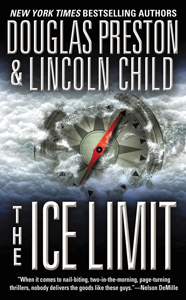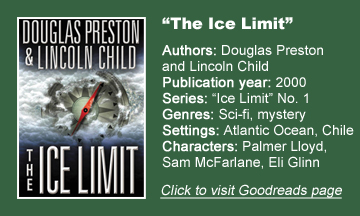Douglas Preston and Lincoln Child take their first excursion beyond the USA, and it’s a memorable one, in “The Ice Limit” (2000). When I think of frigid climates, I think of the Northern Hemisphere – unless it’s Antarctica itself – but the authors remind us that the southern tip of South America is not a pleasant place, especially in the July winter.
It’s cold, windy, mountainous and uninhabited – yet patrolled by quasi-legal operators of the Chilean government.
Adventure trumps science
While the geographical descriptions and adventure are top-shelf, “The Ice Limit” is one of my least favorite of P&C’s early novels because of their focal choice. This is an almost pure adventure novel. I had forgotten how much of “The Ice Limit” is the cat-and-mouse game between our heroes on the oil tanker Rolvaag and the corrupt Chilean general on the warship Almirante Ramirez.
I am more interested in the science. But I almost feel like P&C challenged themselves to see if they could make a sci-fi thriller out of the transport of a large rock from the tip of South America to New York City.
They tease some great scientific mysteries, and the book’s final line provides one big answer, at least, but they are less interested in the science than the adventure. It’s like they accidentally write the seeds of a great sci-fi mystery along the way.
Meteorite hunter Sam McFarlane and scientist Rachel – who strike up a romance – suspect the meteorite comes from outside the solar system, as its atomic weight is not found on the periodic table. It’s also a shade of red not found in nature. Like blue food, this thing should not exist on Earth.
A logistical challenge
Outside of the ocean pursuit, the most drama comes from the logistics of moving the heavy rock. Eli Glinn – later a prominent figure in the Gideon Crew series — is essentially the world’s foremost expert on logistics, and this is the biggest logistical challenge in the world.
Drama comes from workers being in danger of being crushed when the rock shifts in its “cradle” – a transport and securing structure that evenly distributes the rock’s weight to mimic a hold full of oil. I found these passages confusing on my first read, but now I see what P&C are going for.
The ocean pursuit, while not what I wanted out of “The Ice Limit,” is darn good. It goes into the Screaming Sixties, the band of ocean at the 60th parallel that circles the entire globe without hitting land – the only place on Earth where this is the case.
P&C’s descriptions of the Rolvaag’s travels up and down the waves and troughs are evocative. We also get to explore the hauntingly beautiful colors of the water and sky on this alien slice of Earth, plus ice islands as we get closer to The Ice Limit (the rough circle around Antarctic waters where icebergs begin to appear).

People under pressure
“The Ice Limit” boasts subtly good character building that pays off in the climactic argument over whether to dump the meteorite in order to perhaps save the Rolvaag and their lives.
In “Cabinet of Curiosities,” P&C parody a full-of-himself police detective, but “The Ice Limit’s” characterizations of people under pressure maintain archetypal qualities without becoming parodies. It’s partly because we see these people through another person’s eyes: The confident Glinn is seen through Captain Britton’s eyes, and her leadership skills are in turn admired by Glinn.
Meanwhile, Palmer Lloyd, the seventh-richest man in the world who has founded this expedition, switches from a position of abandoning the rock under no circumstance to dumping it to save their lives. True suspense is wrung from not only the high-seas weather, but also the question of how people will behave.
Ultimately, though, “The Ice Limit” is only half of a novel in terms of its scientific mystery – and even in terms of the fates of some characters. It seems like Preston & Child didn’t realize it at the time, because readers begged them for a sequel until they finally delivered “Beyond the Ice Limit” – much more focused on scientific mysteries and philosophy – in 2016.
But readers wanting a high-stakes geography lesson – and those who enjoy logistical drama (if there is such a subgenre) – will find “The Ice Limit” thrilling.


